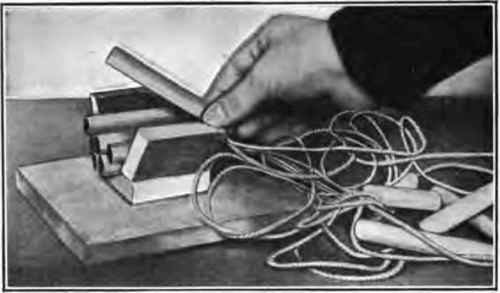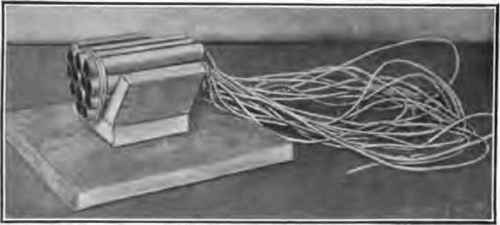Caterpillar Signals
Description
This section is from the book "Military Pyrotechnics", by Henry B. Faber. Also available from Amazon: Military Pyrotechnics.
Caterpillar Signals
(12 Lights.)
The caterpillar signal may have two or more lights, the 12-light signal being the one usually manufactured for military purposes.
It consists of a carton approximately 3 1/3 inches long and 3/8 of an inch inside diameter, which is rolled from 30-pound manila stock sheets 20 by 24 inches. A machine not unlike a cigarette-rolling machine is used for this purpose. The carton is placed on a form and the charge of composition, either white, red or green illuminating mixture, is poured into the case and driven in by a rammer and mallet. The case is filled within an inch of the top. At the bottom of the loaded case there is a slight recess formed by a projection on the block used as a support while loading. This cavity is filled with wet prime up to the level of the edge of the case. At the other end of the case is now inserted a small disk of cardboard cut to a diameter approximately the size of the inside diameter of the carton. This disk has two notches at opposite points on its circumference cut to permit the free passage of a connecting cord.
The connecting cord from which the cartons are suspended is first looped around the cardboard disk and forced, together with the cardboard disk, into the carton where it remains firmly fixed by a drop of glue which is applied on top of the disk.
These several caterpillar cases are spaced approximately 20 inches apart on the supporting cord, one end of which is attached to the parachute string, the other end of the co«d traveling free. This gives a span of about 12 inches between the end of the parachute cord and the first light.
The several lights are nested by means of a form shown in figures 57, 58, and 59.

Fig. 57. - Block used for assembling caterpillar signals.

Fig. 58. - Arrangement of caterpillar signals in block.

Fig. 59. - Caterpillar bundle complete.
When finally stacked as shown in the figure, a string is tied around the end of the lights close to the primed end.
This string holds the battery of lights in place until the prime is ignited, when the string is burned away and the lights hang in a chain in their respective positions.
Great care must be exercised in stacking the lights in order to insure the free uncoiling of the supporting cord. This cord is common hemp twine and does not burn away because it is attached to the light case by means of the disk acting as an anchor in such a manner as to prevent the light from hanging in a perpendicular position, the light or case making an angle with the cord of approximately 45°, thus bringing the burning end well away from the cord.
Continue to:


